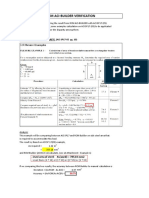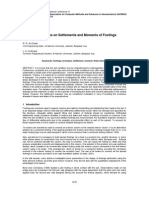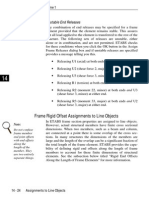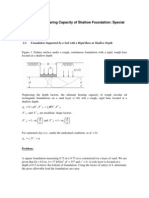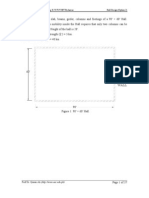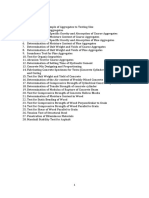Lecture 4 - House Design
Uploaded by
kkhan_451062Lecture 4 - House Design
Uploaded by
kkhan_451062Department of Civil Engineering N-W.F.
P UET Peshawar Design of Concrete Structures (CE-405)
Example No.2: Design the roof slab, beam and column of house given in figure 1.1.
Concrete compressive strength (fc´) = 3 ksi.
Steel yield strength (fy) = 40 ksi.
Load on slab:
4″ thick mud.
2″ thick brick tile.
Live Load = 40 psf
9" Brick masonary wall
S1 12' x 16' S1 12' x 16'
13 12" Brick masonary wall
A
1.5" Expansion joint
S2 9' wide
B1 B1
C1
A
R.C.C Column
Figure 1.1: Slabs S1 and S2 to be designed.
Prof. Dr. Qaisar Ali (qaisarali.onlineuet.com) Page 1 of 18
Department of Civil Engineering N-W.F.P UET Peshawar Design of Concrete Structures (CE-405)
Solution: -
(1) Design of slab “S2”:
Step No 1: Sizes.
lb/la = 24.75/8 = 3.09 > 2 “one way slab”
Assume 5″ slab.
Span length for end span according to ACI 8.7 is minimum of:
(i) l = ln+ hf = 8 + (5/12) = 8.42′
(ii) c/c distance between supports = 9.0625′
1.5" Expansion Joint
13 12" Brick Masonary Wall
l n = 8'-0"
9'-0" wide verandah
l n + (6.75 /12) + 0.5 = 9.0625'
Figure 1.2: Section A-A (see figure 1.1 above).
Therefore l = 8.42′
Slab thickness (hf) = (l/20) x (0.4+fy/100000) [for fy < 60000 psi]
= (8.42/20) x (0.4 + 40000/100000) x 12
= 4.04″ (Minimum requirement of ACI 9.5.2.1).
Therefore take hf = 5″
d = hf – 0.75 – (3/8)/2 = 4″
Step No 2: Loading.
Table 1.1: Dead Loads.
Material Thickness (in) γ (kcf) Load = γ x thickness (ksf)
Slab 5 0.15 0.15 x (5/12) = 0.0625
Mud 4 0.12 0.12 x (4/12) = 0.04
Brick Tile 2 0.12 0.12 x (2/12) = 0.02
Prof. Dr. Qaisar Ali (qaisarali.onlineuet.com) Page 2 of 18
Department of Civil Engineering N-W.F.P UET Peshawar Design of Concrete Structures (CE-405)
Service Dead Load (D.L) = 0.0625 + 0.04 + 0.02
= 0.1225 ksf
Service Live Load (L.L) = 40 psf or 0.04 ksf
Factored Load (wu) = 1.2D.L + 1.6L.L
= 1.2 x 0.1225 + 1.6 x 0.04
= 0.211 ksf
Step No 3: Analysis.
Mu = wul2/8 (l = span length of slab)
Mu = 0.211 x (8.42)2/8
= 1.87 ft-k/ft = 22.44 in-k/ft
Step No 4: Design.
Asmin = 0.002bhf (for fy 40 ksi, ACI 10.5.4)
= 0.002 x 12 x 5 = 0.12 in2
a = Asminfy/ (0.85fc′b)
= 0.12 x 40/ (0.85 x 3 x 12) = 0.156 in
ΦMn(min) = ΦAsminfy (d – a/2)
= 0.9 x 0.12 x 40 x (4 – 0.156/2)
= 16.94 in-k < Mu
Therefore,
• As = Mu/ {Φfy (d – a/2)}
Take a = 0.2d
As = 22.44/ {0.9 x 40 x (4 – (0.2 x 4)/2)}
As = 0.173 in2
• a = 0.173 x 40/ (0.85 x 3 x 12) = 0.226 in
As = 22.44/ {0.9 x 40 x (4 – (0.226/2))}
= 0.160 in2
• a = 0.160 x 40/ (0.85 x 3 x 12) = 0.209 in
As = 22.44/ {0.9 x 40 x (4 – (0.209/2))}
= 0.160 in2, O.K.
Prof. Dr. Qaisar Ali (qaisarali.onlineuet.com) Page 3 of 18
Department of Civil Engineering N-W.F.P UET Peshawar Design of Concrete Structures (CE-405)
Using ½″ Φ (#4) {#13, 13 mm}, with bar area Ab = 0.20 in2
Spacing =Area of one bar (Ab)/As
= [0.20 (in2)/0.160 (in2/ft)] x 12 = 15 in
Using 3/8″ Φ (#3) {#10, 10 mm}, with bar area Ab = 0.11 in2
Spacing = Area of one bar (Ab)/As
= [0.11(in2)/0.160(in2/ft)] x 12 = 7.5″ ≈ 6″
Finally use #3 @ 6″ c/c (#10 @ 225 mm c/c).
Shrinkage steel or temperature steel (Ast):
Ast = 0.002bhf
Ast = 0.002 x 12 x 5 = 0.12 in2
Using 3/8″ Φ (#3) {#10, 10 mm}, with bar area Ab = 0.11 in2
Spacing = Area of one bar (Ab)/Asmin
= (0.11/0.12) x 12 = 11″ c/c
Finally use #3 @ 9″ c/c (#10 @ 225 mm c/c).
• Maximum spacing for main steel in one way slab according to ACI 7.6.5 is
minimum of:
i) 3hf =3 x 5 =15″
ii) 18″
Therefore 6″ spacing is O.K.
• Maximum spacing for shrinkage steel in one way slab according to ACI 7.12.2
is minimum of:
i) 5hf =5 x 5 =25″
ii) 18″
Therefore 9″ spacing is O.K.
(2) Design of slab “S1”:
Step No 1: Sizes.
lb/la = 16/12 = 1.33 < 2 “two way slab”
Minimum depth of two way slab is given by formula,
hmin = perimeter/180
= 2 x (16 + 12) x 12/180 = 3.73 in
Assume h = 5″
Prof. Dr. Qaisar Ali (qaisarali.onlineuet.com) Page 4 of 18
Department of Civil Engineering N-W.F.P UET Peshawar Design of Concrete Structures (CE-405)
Step No 2: Loads.
Factored Load (wu) = wu, dl + wu, ll
wu = 1.2D.L + 1.6L.L
wu = 1.2 x 0.1225 + 1.6 x 0.04 (see table 1.1 above)
= 0.147 + 0.064 = 0.211 ksf
Step No 3: Analysis.
The precise determination of moments in two-way slabs with various conditions
of continuity at the supported edges is mathematically formidable and not suited
to design practice. For this reason, various simplified methods have been adopted
for determining moments, shears, and reactions of such slabs.
According to the 1995 ACI Code, all two-way reinforced concrete slab systems,
including edge supported slabs, flat slabs, and flat plates, are to be analyzed and
designed according to one unified method, such as Direct design Method and
Equivalent Frame Method. However, the complexity of the generalized approach,
particularly for systems that do not meet the requirements permitting analysis by
“direct design method” of the present code, has led many engineers to continue to
use the design method of the 1963 ACI Code for the special case of two-way
slabs supported on four sides of each slab panel by relatively deep, stiff, edge
beams.
This method has been used extensively since 1963 for slabs supported at the
edges by walls, steel beams, or monolithic concrete beams having a total depth
not less than about 3 times the slab thickness. While it was not a part of the 1977
or later ACI Codes, its continued use is permissible under the ACI 318-95 code
provision (13.5.1) that a slab system may be designed by any procedure satisfying
conditions of equilibrium and geometric compatibility, if it is shown that the
design strength at every section is at least equal to the requires strength, and that
serviceability requirements are met.
The method makes use of tables pf moment coefficients for a variety of
conditions. These coefficients are based on elastic analysis but also account for
inelastic redistribution. In consequence, the design moment in either direction is
smaller by an appropriate amount than the elastic maximum moment in that
Prof. Dr. Qaisar Ali (qaisarali.onlineuet.com) Page 5 of 18
Department of Civil Engineering N-W.F.P UET Peshawar Design of Concrete Structures (CE-405)
direction. The moments in the middle strip in the two directions are computed
from:
Ma = Cawla2
And Mb = Cbwlb2
Where Ca, Cb = tabulated moment coefficients
w = uniform load, psf
la, lb = length of clear spans in short and long directions respectively.
Therefore, for the design problem under discussion,
m = la/lb
= 12/16 = 0.75
la = 12'
Case 6
lb = 16'
Figure 1.3: Two way slab (S2)
Table 1.2: Moment coefficients for slab
Case # 6 [m = 0.75]
Coefficients for negative Coefficients for dead load Coefficients for live load
moments in slabs positive moments in slabs positive moments in slabs
Ca,neg Cb,neg Ca,dI Cb,dl Ca,ll Cb,ll
0.088 0 0.048 0.012 0.055 0.016
Refer to tables 12.3 to 12.6, of Nilson 12th Ed.
Ma, neg = Ca, neg x wu x la2
= 0.088 x 0.211 x 122 = 2.67 ft-k = 32.04 in-k
Mb, neg = Cb, neg x wu x lb2
= 0 x 0.211 x 162 = 0 ft-k
M a, pos, dl = C a, pos, dl x wu, dl x la2
Prof. Dr. Qaisar Ali (qaisarali.onlineuet.com) Page 6 of 18
Department of Civil Engineering N-W.F.P UET Peshawar Design of Concrete Structures (CE-405)
= 0.048 x 0.147 x 122 = 1.016 ft-k = 12.19 in-k
M b, pos, dl = C b, pos, dl x wu, dl x lb2
= 0.012 x 0.147 x 162 = 0.45 ft-k = 5.42 in-k
M a, pos, ll = C a, pos, ll x wu, ll x la2
= 0.055 x 0.064 x 122 = 0.51 ft-k = 6.12 in-k
M b, pos, ll = C b, pos, ll x wu, ll x lb2
= 0.016 x 0.064 x 162 = 0.262 ft-k = 3.144 in-k
Therefore, finally we have,
Ma, neg = 2.67 ft-k = 32.04 in-k
Mb, neg = 0 ft-k
Ma, pos, (dl + ll) = 1.016 + 0.51 = 1.53 ft-k = 18.36 in-k
Mb, pos, (dl + ll) = 0.45 + 0.262 = 0.712 ft-k = 8.544 in-k
Step No 4: Design.
Asmin = 0.002bhf = 0.002 x 12 x 5 = 0.12 in2
a = Asminfy/ (0.85fc′b)
= 0.12 x 40/ (0.85 x 3 x 12) = 0.156 in
Φ Mn(min) = ΦAsminfy (d – a/2)
= 0.9x 0.12 x 40 x (4-0.156/2) = 16.94 in-k (capacity provided by Asmin).
Φ Mn(min) is greater than Mb, pos, (dl + ll) but less than Ma, neg and Ma, pos, (dl + ll).
M b, pos, (dl + ll) = 0.712 ft-k = 8.544 in-k < Φ Mn(min)
Therefore, Asmin = 0.12 in2 governs.
Using 3/8″ Φ (#3) {#10, 10 mm}, with bar area Ab = 0.11 in2
Spacing = (0.11/0.12) x 12 = 11″
Maximum spacing according to ACI 13.3.2 for two way slab is:
2hf = 2 x 5 =10″
Therefore maximum spacing of 10″ governs.
Finally use #3 @ 9″ c/c (#10 @ 225 mm c/c).
“Provide #3 @ 9″ c/c as negative reinforcement along the longer direction.”
M a, pos, (dl + ll) = 1.53 ft-k = 18.36 in-k > Φ Mn
Let a = 0.2d = 0.2 x 4 = 0.8 in
As = 1.53 x 12/ {0.9 x 40 x (4 – (0.8/2))} = 0.146 in2
Prof. Dr. Qaisar Ali (qaisarali.onlineuet.com) Page 7 of 18
Department of Civil Engineering N-W.F.P UET Peshawar Design of Concrete Structures (CE-405)
a = 0.146 x 40/ (0.85 x 3 x 12) = 0.191 in
As = 1.53 x 12/ {0.9 x 40 x (4 – 0.191/2)} = 0.131 in2
a = 0.131 x 40/ (0.85 x 3 x 12) = 0.171 in
As = 1.53 x 12/ {0.9 x 40 x (4 – 0.30/2)} = 0.131 in2, O.K
Using 3/8″ Φ (#3) {#10, 10 mm}, with bar area Ab = 0.11 in2
Spacing = 0.11 x 12/0.131 = 10.07″ ≈ 9″ c/c
Finally use #3 @ 9″ c/c (#10 @ 225 mm c/c).
Ma, neg = 2.67 ft-k = 32.04 in-k
Let a = 0.2d = 0.2 x 4 = 0.8 in
As = 2.67 x 12/ {0.9 x 40 x (4 – (0.8/2))} = 0.24 in2
a = 0.24 x 40/ (0.85 x 3 x 12) = 0.31 in
As = 2.67 x 12/ {0.9 x 40 x (4 – 0.31/2)} = 0.23 in2
a = 0.23 x 40/ (0.85 x 3 x 12) = 0.30 in
As = 2.67 x 12/ {0.9 x 40 x (4 – 0.30/2)} = 0.23 in2, O.K.
Using 3/8″ Φ (#3) {#10, 10 mm}, with bar area Ab = 0.11 in2
Spacing = 0.11 x 12/0.23 = 5.7″ ≈ 4.5″ c/c
Finally use #3 @ 4.5″ c/c (#10 @ 110 mm c/c).
(3) BEAM DESIGN (2 span, continuous):
Data Given:
Exterior supports = 9″ brick masonry wall.
fc′ = 3 ksi
fy = 40 ksi
Column dimensions = 12″ x 12″
Step No 1: Sizes.
According to ACI 9.5.2.1, table 9.5 (a):
Minimum thickness of beam with one end continuous = hmin = l/18.5
l = clear span (ln) + depth of member (beam) ≤ c/c distance between supports
[ACI 8.7].
Prof. Dr. Qaisar Ali (qaisarali.onlineuet.com) Page 8 of 18
Department of Civil Engineering N-W.F.P UET Peshawar Design of Concrete Structures (CE-405)
Table 1.3: Clear Spans of beam.
Case Clear span (ln)
End span (one end continuous) 12.375 – (12/12)/2 = 11.875′
Let depth of beam = 18″
ln + depth of beam = 11.875′ + (18/12) = 13.375′
c/c distance between beam supports = 12.375 + (4.5/12) = 12.75′
Therefore l = 12.75′
Depth (h) = (12.75/18.5) x (0.4 + 40000/100000) x 12
= 6.62″ (Minimum requirement of ACI 9.5.2.1).
Take h = 1.5′ = 18″
d = h – 3 = 15″
9" Brick masonry wall 12" x 12" RCC Column
12.375' 12.375'
l n = 12.375 - 12/12 = 11.875' ln = 12.375 - 12/12 = 11.875'
Figure 1.4: c/c distance & clear span of Beam.
Step No 2: Loads.
Service Dead Load (D.L) = 0.0625 + 0.04 + 0.02 = 0.1225 ksf (Table 1.1)
Service Live Load (L.L) = 40 psf or 0.04 ksf
Beam is supporting 5' slab. Therefore load per running foot will be as follows:
Service Dead Load from slab = 0.1225 x 5 = 0.6125 k/ft
Service Dead Load from beam’s self weight = hwbwγc
= (13 x 12/144) x 0.15 = 0.1625 k/ft
Total Dead Load = 0.6125 + 0.1625 = 0.775 k/ft
Service Live Load = 0.04 x 5 = 0.2 k/ft
wu = 1.2D.L + 1.6L.L = 1.2 x 0.775 + 1.6 x 0.20 = 1.25 k/ft
Prof. Dr. Qaisar Ali (qaisarali.onlineuet.com) Page 9 of 18
Department of Civil Engineering N-W.F.P UET Peshawar Design of Concrete Structures (CE-405)
Step No 3: Analysis.
Refer to ACI 8.3.3 or page 396, Nelson 13th Ed, for ACI moment and shear
coefficients.
1) AT INTERIOR SUPPORT:
Negative moment (Mneg) = Coefficient x (wuln2)
= (1/9) x {1.25 x (11.875)2}
= 19.59 ft-k = 235.08 in-k
2) AT MID SPAN:
Positive moment (Mpos) = Coefficient x (wuln2)
= (1/11) x {1.25 x (11.875)2}
= 16.02 ft-k = 192.24 in-k
Vint = 1.15wuln/2 = 1.15 x 1.25 x 11.875/2 = 8.54 k
Vu(int) = 8.54 – 1.25 x 1.25 = 6.97 k
Vext = wuln/2 = 1.25 x 11.875/2 = 7.42 k
Vu(ext) = 7.42 – 1.25 x 1.25 = 5.86 k
wu = 1.25 k/ft
ln = 11.875' ln = 11.875'
wu ln /2 1.15wu ln /2
ACI Shear
1.15wu ln /2 wu ln /2 Coefficients
Vu (ext) = 5.86 k
7.42 k
d = 1.25'
8.54 k
Vu(int) = 6.97 k
1/ 11 1/ 11 ACI Moment
0 0 Coefficients
1/ 9 1/ 9
192.24 in-k 192.24 in-k
235.08 in-k
Figure 1.5: Approximate shear force and bending moment diagrams.
Prof. Dr. Qaisar Ali (qaisarali.onlineuet.com) Page 10 of 18
Department of Civil Engineering N-W.F.P UET Peshawar Design of Concrete Structures (CE-405)
Step No 4: Design.
(A) Flexural Design:
(1) For Positive Moment:
Step (a): According to ACI 8.10, beff for L-beam is minimum of:
(i) 6hf + bw = 6 x 5 + 12= 42″
(ii) bw + Span length of beam/12 = 12 + (12.75 x 12) /12 = 24.75″
(iii)Clear distance to the next web = Not Applicable
So beff = 24.75″
Step (b): Check if beam is to be designed as rectangular beam or L-beam.
(i). Assume a = hf = 5″
As = Mu/ {Φfy (d – a/2)}
As = 192.24/ {0.9 x 40 x (15-5/2)} = 0.427 in2
(ii).Re-calculate “a”:
a = Asfy/ (0.85fc′beff)
a = 0.427 x 40/ (0.85 x 3 x 24.75) = 0.271″ <hf
Therefore design beam as rectangular.
Trial #1:
As = 192.24/ {0.9 x 40 x (15 – 0.271/2)} = 0.359 in2
a = 0.359 x 40/ (0.85 x 3 x 24.75) = 0.228″
Trial #2:
As =192.24/ {0.9 x 40 x (15 – 0.228/2)} = 0.358 in2, O.K.
Step (c): Check for maximum and minimum reinforcement.
Asmax = ρmaxbwd
ρmax = 0.85 x 0.85 x (3/40) x {0.003/(0.003 + 0.005)} = 0.0203
Asmax = 0.0203 x 12 x 15 = 3.654 in2
Asmin = ρminbwd
Asmin = 0.005 x 12 x 15 = 0.9 in2
As = 0.358 in2 < Asmin, so Asmin governs.
Using 5/8″ Φ (#5) {#16, 16 mm}, with bar area Ab = 0.31 in2
No. of bars = As/Ab
= 0.90/0.31 = 2.90 ≈ 3 bars
Use 4 #5 bars {4 # 16 bars, 16 mm}.
Prof. Dr. Qaisar Ali (qaisarali.onlineuet.com) Page 11 of 18
Department of Civil Engineering N-W.F.P UET Peshawar Design of Concrete Structures (CE-405)
(2) For Interior Negative Moment:
Step (a): Now we take bw = 12″ instead of beff for calculation of “a” because of
flange in tension.
Mu = 235.08 in-k
bw = 12″
h = 18″
d = 15″
(i) Trial #1:
As =Mu/ {Φfy (d – a/2)}
Let a = 0.2d
As =235.08 / [0.9 x 40 x {15-(0.2 x 15)/2)}] = 0.484 in2
a = 0.484 x 40/ (0.85 x 3 x 12) = 0.632″
(ii) Trial #2:
As = 235.08/ {0.9 x 40 x (15 – 0.632/2)} = 0.44 in2
a = 0.44 x 40/ (0.85 x 3 x 12) = 0.58″
(iii)Trial #3:
As = 235.08/ {0.9 x 40 x (15 – 0.58/2)} = 0.44 in2 <Asmin
So Asmin governs.
Using 5/8″ Φ (#5) {#16, 16 mm}, with bar area Ab = 0.31 in2
No. of bars = As/Ab
= 0.90/0.31 = 2.90 ≈ 3 bars
Use 4 #5 bars {4 # 16 bars, 16 mm}.
(B) Shear Design for beam:
Step (a):
d = 15″ = 1.25′
Vu (ext) = 5.86 k
Vu (int) = 6.97 k
Step (b):
ΦVc = Φ2√ (fc′)bwd
= {0.75 x 2 x √ (3000) x 12 x 15}/1000 = 14.78 k > Vu (ext) & Vu (int).
Theoretically, no shear reinforcement is required, but minimum will be provided.
Prof. Dr. Qaisar Ali (qaisarali.onlineuet.com) Page 12 of 18
Department of Civil Engineering N-W.F.P UET Peshawar Design of Concrete Structures (CE-405)
Maximum spacing (smax) permitted by ACI 11.5.4 shall be minimum of:
(i) Avfy/(50bw) = 0.22 x 40000/(50 x 12) =14.67″ c/c
(ii) d/2 =15/2 =7.5″ c/c
(iii)24″ c/c
Other checks:
(a) Check for depth of beam {ACI 11.5.6.9}:
ΦVs ≤ Φ8√ (fc′)bwd
Φ8√ (fc′)bwd = 0.75 x 8 x √ (3000) x 12 x 15/1000
= 59.14 k
ΦVs = (ΦAvfyd)/sd
= (0.75 x 0.22 x 40 x 15)/7.5 = 13.2 k < 82.8 k, O.K.
So depth is O.K. If not, increase depth of beam.
(b) Check for spacing given under “maximum spacing requirement of ACI":
ΦVs ≤ Φ4√ (fc′)bwd. {ACI 11.5.4.3}
Φ4√ (fc´)bwd = 0.75 x 4 x √ (3000) x 12 x 15/1000
= 29.57 k
ΦVs = (ΦAvfyd)/sd
= (0.75 x 0.22 x 40 x 21)/7.5 = 13.2 k < 29.57 k, O.K.
Therefore spacing given under “maximum spacing requirement of ACI" is
O.K. Otherwise reduce spacing by half.
Provide # 3, 2 legged @ 7.5″ c/c {#10, 2 legged stirrups @ 190 mm c/c}
throughout, starting at sd/2 = 7.5/2 = 3.75″ from the face of the support.
(4) DESIGN OF COLUMN:
i) Load on column:
Pu = 2Vint = 2 x 8.54 = 17.08 k (Reaction at interior support of beam)
Gross area of column cross-section (Ag) = 12 x 12 =144 in2
fc′ = 3 ksi
fy = 40 ksi
ii) Design:
Nominal strength (ΦPn) of axially loaded column is:
ΦPn = 0.80Φ {0.85fc′ (Ag – Ast) + Astfy} {for tied column, ACI 10.3.6}
Prof. Dr. Qaisar Ali (qaisarali.onlineuet.com) Page 13 of 18
Department of Civil Engineering N-W.F.P UET Peshawar Design of Concrete Structures (CE-405)
Let Ast = 1% of Ag (Ast is the main steel reinforcement area)
ΦPn = 0.80 x 0.65 x {0.85 x 3 x (144 – 0.01 x 144) + 0.01 x 144 x 40}
= 218.98 k > (Pu = 17.08 k), O.K.
Ast =0.01 x 144 =1.44 in2
Using 3/4″ Φ (#6) {# 19, 19 mm}, with bar area Ab =0.44 in2
No. of bars = As/Ab
= 1.44/0.44 = 3.27 ≈ 4 bars
Use 4 #6 bars {4 #19 bars, 19 mm}.
Tie bars:
Using 3/8″ Φ (#3) {#10, 10 mm} tie bars for 3/4″ Φ (#6) {#19, 19 mm} main bars
(ACI 7.10.5),
Spacing for Tie bars according to ACI 7.10.5.1 is minimum of:
(a) 16 x dia of main bar =16 x 3/4 =12″ c/c
(b) 48 x dia of tie bar = 48 x (3/8) =18″ c/c
(c) Least column dimension =12″ c/c
Finally use #3, tie bars @ 9″ c/c (#10, tie bars @ 300 mm c/c).
Prof. Dr. Qaisar Ali (qaisarali.onlineuet.com) Page 14 of 18
Department of Civil Engineering N-W.F.P UET Peshawar Design of Concrete Structures (CE-405)
(5) Drafting:
(A) Slab “S1” and “S2”:
B
A A
MT2 MT2
MT1 MT2
MT2
M1 M1
M1 M1
S1 12' x 16' MT2 S1 12' x 16' MT2
M1 MT2
S2 8' wide MT2
M2
B1 B1
C1
B
Depth Bottom
Panel (in) Mark Reinforcement Mark Top reinforcement
3/8" φ @ 4.5" c/c Non continuous End
M1 3/8" φ @ 9" c/c MT1
3/8" φ @ 4.5" c/c Continouos End
S1 5"
M1 3/8" φ @ 9" c/c MT2 3/8" φ @ 9" c/c Non continuous Ends
M2 3/8" φ @ 6" c/c
S2 5" MT2 3/8" φ @ 9" c/c Non Continuous End
M1 3/8" φ @ 9" c/c
Prof. Dr. Qaisar Ali (qaisarali.onlineuet.com) Page 15 of 18
Department of Civil Engineering, N-W.F.P UET Peshawar Design of Concrete Structures (CE-405)
#3 @ 9" c/c
#3 @ 9" c/c #3 @ 6" c/c #3 @ 4.5" c/c
L1/4 = 3'-0" L1/3 = 4'-0"
h = 5"
#3 @ 9" c/c
L1 = 12'-0"
SECTION A-A
1.5" Expansion Joint
#3 @ 4.5" c/c #3 @ 9" c/c
#3 @ 9" c/c #3 @ 9" c/c
#3 @ 9" c/c
L2/4 = 4'-0" L2/4 = 4'-0" L/4=2'-0" L/4=2'-0"
12" x 18" Beam
#3 @ 9" c/c #3 @ 9" c/c
13 12" Brick Masonary Wall
L 2= 16'-0" L = 8'-0"
SECTION B-B
Prof. Dr. Qaisar Ali (qaisarali.onlineuet.com) Page 16 of 18
Department of Civil Engineering, N-W.F.P UET Peshawar Design of Concrete Structures (CE-405)
(B) Beam:
2 #5 Bars
A B B
A
0.33L = 4'-0" 0.33L = 4'-0"
4 #5 Bars #3, 2 legged stirrups @ 7.5" c/c
A B B A
4 #5 Bars 4 #5 Bars
s /2=3.75"
L = 11'-10.5" L = 11'-10.5"
BEAM DETAIL
Notes: -
(1) Use graph A.3, Nelson 13th Ed for location of cut off for continuous beams..
(2) Use table A.7, Nelson 13th Ed for maximum number of bars as a single layer in beam stem.
2 #5 Bars 5" 4 #5 Bars 5"
#3,2 legged stirrups @ 7.5" c/c #3,2 legged stirrups @ 7.5" c/c
18" 18"
4 #5 Bars 4 #5 Bars
12" 12"
SECTION A-A SECTION B-B
Prof. Dr. Qaisar Ali (qaisarali.onlineuet.com) Page 17 of 18
Department of Civil Engineering N-W.F.P UET Peshawar Design of Concrete Structures (CE-405)
(C) Column:
#3 ties @ 9" c/c
4 #6 Bars
12"
4 #6 Bars
#3 Ties @ 9" c/c
12"
12"
Column (C1) Detail
Prof. Dr. Qaisar Ali (qaisarali.onlineuet.com) Page 18 of 18
You might also like
- Concrete Lectures Slab.2 Direct Design Method - PPT ExamplesNo ratings yetConcrete Lectures Slab.2 Direct Design Method - PPT Examples58 pages
- Wind Load Calculation - ASCE7-05 Method-1, Simplified Procedure - MWFRSNo ratings yetWind Load Calculation - ASCE7-05 Method-1, Simplified Procedure - MWFRS3 pages
- CEE 411 Steel Structures W10-L01: Flexural Member Introduction, Analysis/Design StepsNo ratings yetCEE 411 Steel Structures W10-L01: Flexural Member Introduction, Analysis/Design Steps39 pages
- Influence Lines For Statically Indeterminate Structures Lectures NotesNo ratings yetInfluence Lines For Statically Indeterminate Structures Lectures Notes43 pages
- Two Way Slab Direct Design Method (DDM) : Eng - Loai TarabulsiNo ratings yetTwo Way Slab Direct Design Method (DDM) : Eng - Loai Tarabulsi45 pages
- A. Shear and Moment Diagram: Draw The Shear and Moment Diagrams For The Beam Shown. Segments AC and CE Are Connected by Pin CNo ratings yetA. Shear and Moment Diagram: Draw The Shear and Moment Diagrams For The Beam Shown. Segments AC and CE Are Connected by Pin C4 pages
- CH-1 EXAMPLE 1b (Moment Redistribution)No ratings yetCH-1 EXAMPLE 1b (Moment Redistribution)19 pages
- University of Engineering and Technology Lahore: Steel Structures Lab Design AssignmentNo ratings yetUniversity of Engineering and Technology Lahore: Steel Structures Lab Design Assignment18 pages
- Instructor's Solutions Manual: Design of Concrete Structures, 13e0% (1)Instructor's Solutions Manual: Design of Concrete Structures, 13e34 pages
- Course Content - Complete Design of G+3 Storey RCC Building As Per Is Codes by ETABSNo ratings yetCourse Content - Complete Design of G+3 Storey RCC Building As Per Is Codes by ETABS9 pages
- Wf-Section Compression Strength LRFD Method Per NSCP 2015 Edition (S.I. Units) Developed By: Joel M. Regino, CE, RMPNo ratings yetWf-Section Compression Strength LRFD Method Per NSCP 2015 Edition (S.I. Units) Developed By: Joel M. Regino, CE, RMP1 page
- I.S. Code Download - World of Civil EngineerNo ratings yetI.S. Code Download - World of Civil Engineer23 pages
- Chapter 7: Introduction To Column Analogy MethodNo ratings yetChapter 7: Introduction To Column Analogy Method42 pages
- Chapter 2 Shallow Foundation - Special CasesNo ratings yetChapter 2 Shallow Foundation - Special Cases4 pages
- Moment Distribution and Moment Re-Distribution100% (1)Moment Distribution and Moment Re-Distribution44 pages
- Lecture - 11 Analysis and Design of Two-Way Slab Systems (Two-Way Slab With Beams & Two Way Joist Slabs) - 2No ratings yetLecture - 11 Analysis and Design of Two-Way Slab Systems (Two-Way Slab With Beams & Two Way Joist Slabs) - 264 pages
- Direct Strength Method For THE Analysis and Design of Cold-Formed Steel SectionsNo ratings yetDirect Strength Method For THE Analysis and Design of Cold-Formed Steel Sections27 pages
- Structural Analysis and Design Tcm4-118204No ratings yetStructural Analysis and Design Tcm4-118204140 pages
- Full Hand Calculation, Analysis and Design of Multi Story Building IINo ratings yetFull Hand Calculation, Analysis and Design of Multi Story Building II2 pages
- Lecture #1 Design of Reinforced Concrete Structures100% (6)Lecture #1 Design of Reinforced Concrete Structures25 pages
- Computerised Conceret Design by Engr. Ben David PDFNo ratings yetComputerised Conceret Design by Engr. Ben David PDF309 pages
- Reinforced Concrete Vol 1 by HJ Shah PDFNo ratings yetReinforced Concrete Vol 1 by HJ Shah PDF2 pages
- Numerical Methods and Implementation in Geotechnical Engineering – Part 1From EverandNumerical Methods and Implementation in Geotechnical Engineering – Part 1No ratings yet
- L 03 Analysis and Design of One Way Slab System Part II Dec 2014No ratings yetL 03 Analysis and Design of One Way Slab System Part II Dec 201437 pages
- Design Slab, Beam, Girder, Column & Footings of A 90ft X 60ft83% (23)Design Slab, Beam, Girder, Column & Footings of A 90ft X 60ft37 pages
- CE305 Reinforced Concrete Design: Topics: Examples On T Beam Design WEEK: 11 Level: 6 Prerequisites: NoneNo ratings yetCE305 Reinforced Concrete Design: Topics: Examples On T Beam Design WEEK: 11 Level: 6 Prerequisites: None22 pages
- Soil Loss Estimation Using GIS and Remote Sensing Techniques: A Case of Koga Watershed, Northwestern EthiopiaNo ratings yetSoil Loss Estimation Using GIS and Remote Sensing Techniques: A Case of Koga Watershed, Northwestern Ethiopia4 pages
- Background and Goal of Study: 1. Municipal Solid Waste Collection Efficiency and Ground DumpingNo ratings yetBackground and Goal of Study: 1. Municipal Solid Waste Collection Efficiency and Ground Dumping2 pages
- 5.review Report Remote Sensing and GIS Based WetlandNo ratings yet5.review Report Remote Sensing and GIS Based Wetland2 pages
- Short Essay For School Students On A Morning WalkNo ratings yetShort Essay For School Students On A Morning Walk6 pages
- Name: Akbar Khan CMSID: 29175 Subject: PRC 2 Assignment #2 (ACI Codes 318-08) Submitted To: ENGR Jahanzaib Shah Semester: 7No ratings yetName: Akbar Khan CMSID: 29175 Subject: PRC 2 Assignment #2 (ACI Codes 318-08) Submitted To: ENGR Jahanzaib Shah Semester: 71 page
- Name: Kamran Ullah Khan CMSID: 29293 Subject: PRC 2 Assignment #2 (ACI Codes 318-08) Submitted To: ENGR Jahanzaib Shah Semester: 7No ratings yetName: Kamran Ullah Khan CMSID: 29293 Subject: PRC 2 Assignment #2 (ACI Codes 318-08) Submitted To: ENGR Jahanzaib Shah Semester: 71 page
- Name: Hazem Emam Ali Section: 2 I.D: 13P1082 Building Engineering Materials AssignmentNo ratings yetName: Hazem Emam Ali Section: 2 I.D: 13P1082 Building Engineering Materials Assignment5 pages
- Experimental Performance of Concrete Using Sugarcane Bagasse Ash (Scba) and Coal Bottom Ash (CBA)No ratings yetExperimental Performance of Concrete Using Sugarcane Bagasse Ash (Scba) and Coal Bottom Ash (CBA)5 pages
- Flood Resistant Construction Techniques Used Around The WorldNo ratings yetFlood Resistant Construction Techniques Used Around The World7 pages
- Prefabricated Construction: G.X.BERINDANEL, Berindanel@gmail - Co m,+919442173484No ratings yetPrefabricated Construction: G.X.BERINDANEL, Berindanel@gmail - Co m,+91944217348414 pages
- Is 456 2000 Most Expected Questions (Avnish Sir) 30-03-22No ratings yetIs 456 2000 Most Expected Questions (Avnish Sir) 30-03-2235 pages
- Pull-Out Testing by LOK-test and CAPO-testNo ratings yetPull-Out Testing by LOK-test and CAPO-test141 pages
- Epoxy Repair Mortar TDS FloArm-ERM-Ver-6 24-01-2023No ratings yetEpoxy Repair Mortar TDS FloArm-ERM-Ver-6 24-01-20233 pages
- Amex Knitting & Dyeing Industries Ltd. (Unit 2)No ratings yetAmex Knitting & Dyeing Industries Ltd. (Unit 2)17 pages
- Reference 101. Effect of Fibers in Concrete CompositesNo ratings yetReference 101. Effect of Fibers in Concrete Composites13 pages
- Certification of Ready Mixed Concrete Production FacilitiesNo ratings yetCertification of Ready Mixed Concrete Production Facilities16 pages
- Test Method For Water, Acid and Alkali Resistance of Continuous Fiber Sheets (Jsce-E 549-2000)No ratings yetTest Method For Water, Acid and Alkali Resistance of Continuous Fiber Sheets (Jsce-E 549-2000)11 pages
- Asphalt Mixtures Emission and Energy Consumption: A ReviewNo ratings yetAsphalt Mixtures Emission and Energy Consumption: A Review12 pages
- BS 1881-119 1983 - Testing Concrete - Determination of Compressive StrengthNo ratings yetBS 1881-119 1983 - Testing Concrete - Determination of Compressive Strength8 pages
- Concrete Lectures Slab.2 Direct Design Method - PPT ExamplesConcrete Lectures Slab.2 Direct Design Method - PPT Examples
- Wind Load Calculation - ASCE7-05 Method-1, Simplified Procedure - MWFRSWind Load Calculation - ASCE7-05 Method-1, Simplified Procedure - MWFRS
- CEE 411 Steel Structures W10-L01: Flexural Member Introduction, Analysis/Design StepsCEE 411 Steel Structures W10-L01: Flexural Member Introduction, Analysis/Design Steps
- Influence Lines For Statically Indeterminate Structures Lectures NotesInfluence Lines For Statically Indeterminate Structures Lectures Notes
- Two Way Slab Direct Design Method (DDM) : Eng - Loai TarabulsiTwo Way Slab Direct Design Method (DDM) : Eng - Loai Tarabulsi
- A. Shear and Moment Diagram: Draw The Shear and Moment Diagrams For The Beam Shown. Segments AC and CE Are Connected by Pin CA. Shear and Moment Diagram: Draw The Shear and Moment Diagrams For The Beam Shown. Segments AC and CE Are Connected by Pin C
- University of Engineering and Technology Lahore: Steel Structures Lab Design AssignmentUniversity of Engineering and Technology Lahore: Steel Structures Lab Design Assignment
- Instructor's Solutions Manual: Design of Concrete Structures, 13eInstructor's Solutions Manual: Design of Concrete Structures, 13e
- Course Content - Complete Design of G+3 Storey RCC Building As Per Is Codes by ETABSCourse Content - Complete Design of G+3 Storey RCC Building As Per Is Codes by ETABS
- Wf-Section Compression Strength LRFD Method Per NSCP 2015 Edition (S.I. Units) Developed By: Joel M. Regino, CE, RMPWf-Section Compression Strength LRFD Method Per NSCP 2015 Edition (S.I. Units) Developed By: Joel M. Regino, CE, RMP
- Lecture - 11 Analysis and Design of Two-Way Slab Systems (Two-Way Slab With Beams & Two Way Joist Slabs) - 2Lecture - 11 Analysis and Design of Two-Way Slab Systems (Two-Way Slab With Beams & Two Way Joist Slabs) - 2
- Direct Strength Method For THE Analysis and Design of Cold-Formed Steel SectionsDirect Strength Method For THE Analysis and Design of Cold-Formed Steel Sections
- Full Hand Calculation, Analysis and Design of Multi Story Building IIFull Hand Calculation, Analysis and Design of Multi Story Building II
- Lecture #1 Design of Reinforced Concrete StructuresLecture #1 Design of Reinforced Concrete Structures
- Computerised Conceret Design by Engr. Ben David PDFComputerised Conceret Design by Engr. Ben David PDF
- Numerical Methods and Implementation in Geotechnical Engineering – Part 1From EverandNumerical Methods and Implementation in Geotechnical Engineering – Part 1
- L 03 Analysis and Design of One Way Slab System Part II Dec 2014L 03 Analysis and Design of One Way Slab System Part II Dec 2014
- Design Slab, Beam, Girder, Column & Footings of A 90ft X 60ftDesign Slab, Beam, Girder, Column & Footings of A 90ft X 60ft
- CE305 Reinforced Concrete Design: Topics: Examples On T Beam Design WEEK: 11 Level: 6 Prerequisites: NoneCE305 Reinforced Concrete Design: Topics: Examples On T Beam Design WEEK: 11 Level: 6 Prerequisites: None
- Soil Loss Estimation Using GIS and Remote Sensing Techniques: A Case of Koga Watershed, Northwestern EthiopiaSoil Loss Estimation Using GIS and Remote Sensing Techniques: A Case of Koga Watershed, Northwestern Ethiopia
- Background and Goal of Study: 1. Municipal Solid Waste Collection Efficiency and Ground DumpingBackground and Goal of Study: 1. Municipal Solid Waste Collection Efficiency and Ground Dumping
- 5.review Report Remote Sensing and GIS Based Wetland5.review Report Remote Sensing and GIS Based Wetland
- Name: Akbar Khan CMSID: 29175 Subject: PRC 2 Assignment #2 (ACI Codes 318-08) Submitted To: ENGR Jahanzaib Shah Semester: 7Name: Akbar Khan CMSID: 29175 Subject: PRC 2 Assignment #2 (ACI Codes 318-08) Submitted To: ENGR Jahanzaib Shah Semester: 7
- Name: Kamran Ullah Khan CMSID: 29293 Subject: PRC 2 Assignment #2 (ACI Codes 318-08) Submitted To: ENGR Jahanzaib Shah Semester: 7Name: Kamran Ullah Khan CMSID: 29293 Subject: PRC 2 Assignment #2 (ACI Codes 318-08) Submitted To: ENGR Jahanzaib Shah Semester: 7
- Name: Hazem Emam Ali Section: 2 I.D: 13P1082 Building Engineering Materials AssignmentName: Hazem Emam Ali Section: 2 I.D: 13P1082 Building Engineering Materials Assignment
- Experimental Performance of Concrete Using Sugarcane Bagasse Ash (Scba) and Coal Bottom Ash (CBA)Experimental Performance of Concrete Using Sugarcane Bagasse Ash (Scba) and Coal Bottom Ash (CBA)
- Flood Resistant Construction Techniques Used Around The WorldFlood Resistant Construction Techniques Used Around The World
- Prefabricated Construction: G.X.BERINDANEL, Berindanel@gmail - Co m,+919442173484Prefabricated Construction: G.X.BERINDANEL, Berindanel@gmail - Co m,+919442173484
- Is 456 2000 Most Expected Questions (Avnish Sir) 30-03-22Is 456 2000 Most Expected Questions (Avnish Sir) 30-03-22
- Epoxy Repair Mortar TDS FloArm-ERM-Ver-6 24-01-2023Epoxy Repair Mortar TDS FloArm-ERM-Ver-6 24-01-2023
- Reference 101. Effect of Fibers in Concrete CompositesReference 101. Effect of Fibers in Concrete Composites
- Certification of Ready Mixed Concrete Production FacilitiesCertification of Ready Mixed Concrete Production Facilities
- Test Method For Water, Acid and Alkali Resistance of Continuous Fiber Sheets (Jsce-E 549-2000)Test Method For Water, Acid and Alkali Resistance of Continuous Fiber Sheets (Jsce-E 549-2000)
- Asphalt Mixtures Emission and Energy Consumption: A ReviewAsphalt Mixtures Emission and Energy Consumption: A Review
- BS 1881-119 1983 - Testing Concrete - Determination of Compressive StrengthBS 1881-119 1983 - Testing Concrete - Determination of Compressive Strength








